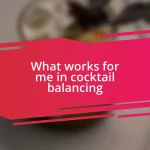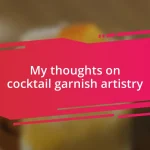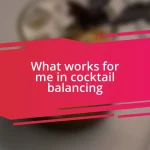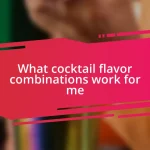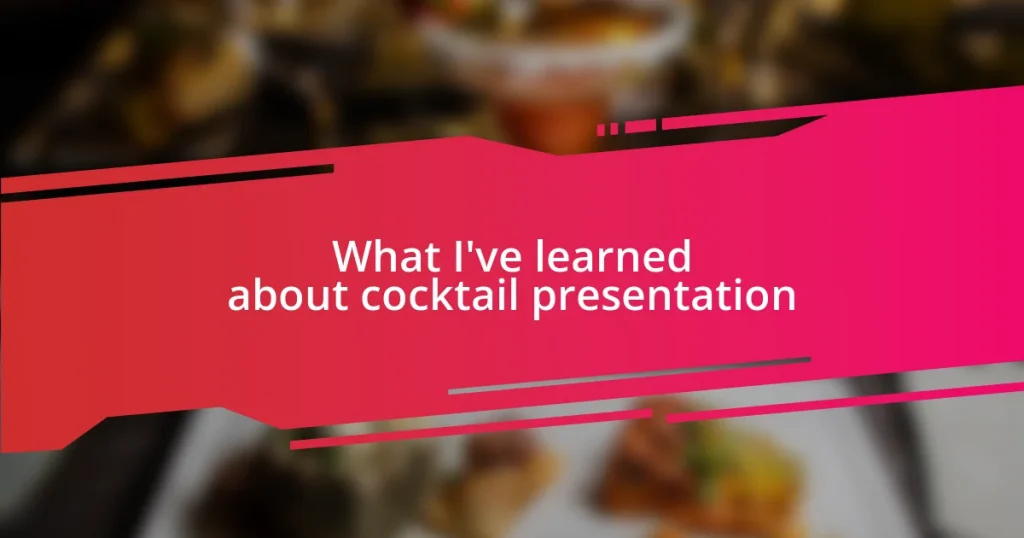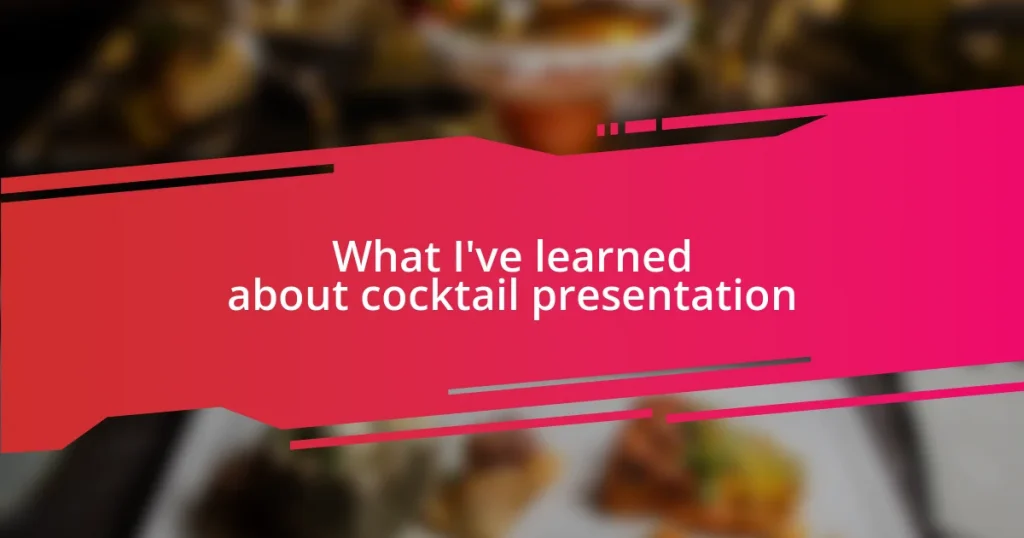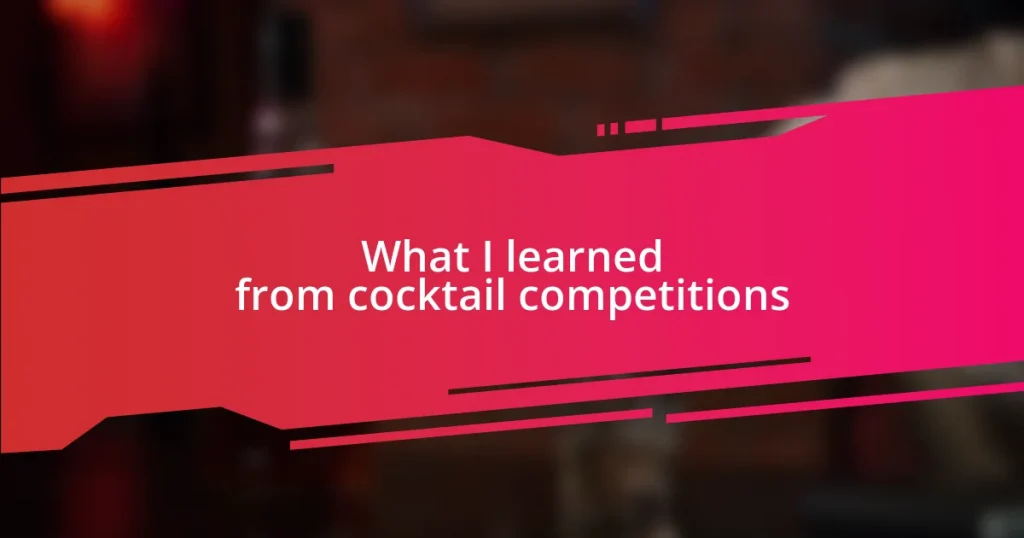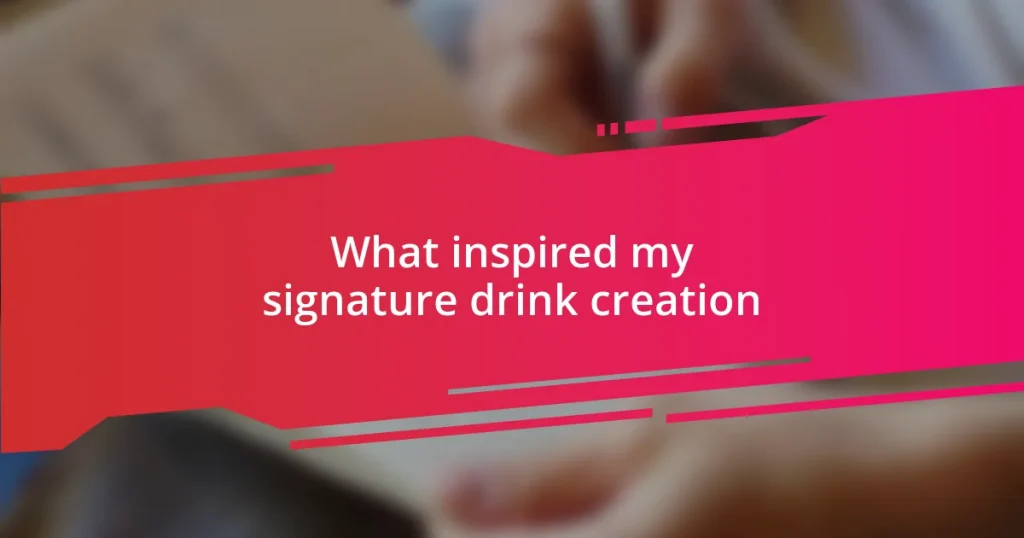Key takeaways:
- Cocktail presentation enhances the overall drinking experience by engaging the senses and setting the mood.
- Essential tools, including mixing glasses, garnishing tools, and appropriate glassware, significantly impact both visual appeal and taste perception.
- Utilizing color theory and balance in garnishing can transform cocktails into captivating creations that evoke specific moods and atmospheres.

Understanding cocktail presentation importance
Cocktail presentation is crucial because it transforms an ordinary drink into an experience. I remember the first time I sipped a well-crafted cocktail adorned with fresh herbs and vibrant garnishes—it was visually captivating and made the drink taste even better. Isn’t it fascinating how our eyes are often the first to delight our senses?
When a cocktail is presented beautifully, it sets the tone for the entire drinking experience. Picture this: you’re at a cozy bar, and the bartender hands you a cocktail that seems to glow under soft lighting. The color contrasts and elegant glassware draw you in, making you savor not just the taste but the visual artistry. In moments like this, I often ask myself, how much does a drink’s appearance influence our enjoyment?
Crafting a cocktail’s presentation is more than just aesthetics; it communicates creativity and attention to detail. I once attended a cocktail workshop where the instructor emphasized the importance of color theory. And let me tell you, the impact of a strikingly composed drink was undeniable—the flavors seemed to leap out, making me appreciate the mixology artistry behind it. It’s those small details that transform mere beverages into captivating stories, don’t you think?

Essential tools for cocktail presentation
When it comes to cocktail presentation, having the right tools is essential. A good mixing glass, for example, not only aids in creating the perfect blend but also enhances the visual impact of the drink. I recall using a beautiful crystal mixing glass during a dinner party; it elevated the entire experience and made my guests feel like they were in a high-end bar.
Garnishing tools are another must-have in your presentation toolkit. I used to think that garnishes were just for show, but one evening, I experimented with different herbs and colorful fruits, and it was a game changer. The addition of a sprig of mint or a slice of citrus not only makes the drink pop visually but also adds aromatic elements that heighten the tasting experience. Don’t underestimate the power of a well-placed garnish—it’s often the first thing people notice, and it can elevate an ordinary cocktail to something out of the ordinary.
Lastly, the importance of glassware cannot be overstated. Different types of glasses can alter the way a cocktail is perceived. I remember serving a classic mojito in a tall, slender glass and noticing how the height made it appear more refreshing. Choosing the right glass adds a layer of sophistication to the presentation and enhances the overall experience. Which cocktail glass do you think your creation deserves?
| Tool | Purpose |
|---|---|
| Mixing Glass | Helps in creating cocktails while enhancing visual presentation. |
| Garnishing Tools | Adds aromatic and visual appeal to cocktails. |
| Glassware | Shapes perception and presentation of cocktails. |

Techniques for eye-catching garnishes
When it comes to garnishing, creativity knows no bounds. I’ve found that utilizing seasonal ingredients can really make a drink stand out. For instance, one summer evening, I decided to host a tropical-themed gathering and chose fresh fruits like pineapples and kiwis as garnishes. The bright colors not only enhanced the visual appeal but also created a vibrant atmosphere that my guests loved. Seeing their faces light up as they noticed the playful presentation was a rewarding experience in itself.
There are several effective techniques to make your garnishes truly captivating:
- Layering: Use multiple elements, such as herbs layered with citrus, to create depth and intrigue.
- Textures: Incorporate crunchy elements like candied ginger or sprouted seeds for added dimensionality.
- Symmetry and Asymmetry: Play with balanced and unbalanced designs to catch the eye in different ways.
- Color Contrasts: Use contrasting colors to highlight the drink—think bright green mint leaves against a vibrant red cocktail.
- Unexpected Shapes: Experiment with spiral-cut fruits or long herb sprigs to introduce unique shapes that spark curiosity.
Every time I take the time to thoughtfully select and arrange garnishes, it transforms not only the drink but the entire ambiance of the occasion. Trust me: a well-executed garnish is like a warm welcome to flavor and creativity.

Glassware selection for cocktails
Choosing the right glassware for cocktails is one of the most impactful decisions a mixologist can make. I remember a time when I served an espresso martini in a classic coupe glass; the elegant curve of the glass not only highlighted the creamy top but also felt sophisticated in my hand. It’s fascinating how something as simple as glass shape can elevate the drinking experience—have you ever noticed how a classic old fashioned tastes even better in a heavy rocks glass?
Each cocktail has a kind of “home” that complements its flavor profile and presentation style. For instance, using a tiki mug for a fruity, rum-infused concoction adds an element of fun, while a highball glass speaks to the refreshing nature of drinks like gin and tonic. I found it particularly rewarding to experiment with themed glassware during a romantic dinner; pairing my signature cocktail with a beautiful, ornate glass sparked delightful conversations and made the evening memorable.
Don’t forget that the temperature of the glass can also influence the drink’s overall quality. A chilled glass for serving a margarita enhances its crispness, while a warm glass can dull the experience. It’s these little details I’ve come to cherish that transform an average cocktail night into something truly extraordinary. What kind of glass do you visualize for your next cocktail masterpiece?
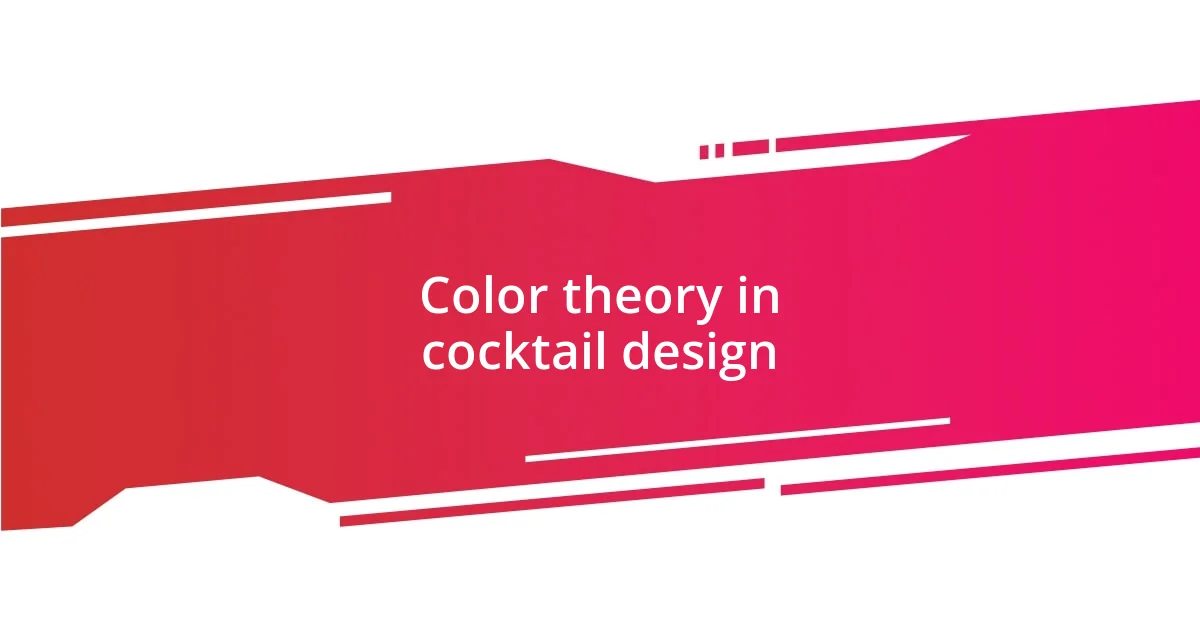
Color theory in cocktail design
Color plays a pivotal role in cocktail design, influencing everything from the drink’s appeal to the mood it evokes. I remember one evening when I crafted a layered sunset cocktail with vibrant orange and deep purple hues. Watching the colors meld together in the glass instantly transported my guests to a tropical paradise. Isn’t it amazing how color can transform an ordinary drink into an inviting escape?
Understanding color theory is essential for creating visually striking cocktails. For instance, complementary colors, those that sit opposite each other on the color wheel, can make a cocktail pop. I’ve experimented with garnishing a bright yellow drink, like a pineapple daiquiri, with deep blue berries. This contrast not only caught the eye but also tantalized the taste buds with a blend of sweet and tart flavors. Have you ever considered how colors can set the stage for the flavors you want to evoke?
Additionally, the psychological aspects of color should never be overlooked in the art of cocktail presentation. Warm colors like red and orange can stimulate excitement and energy, perfect for a lively gathering. In contrast, cool colors such as green and blue can convey calm and relaxation, making them suitable for a quiet evening. One cozy night, I served a serene blue cocktail, and its calming hue encouraged everyone to unwind and connect. How do you think the colors of your cocktails affect the atmosphere at your gatherings?
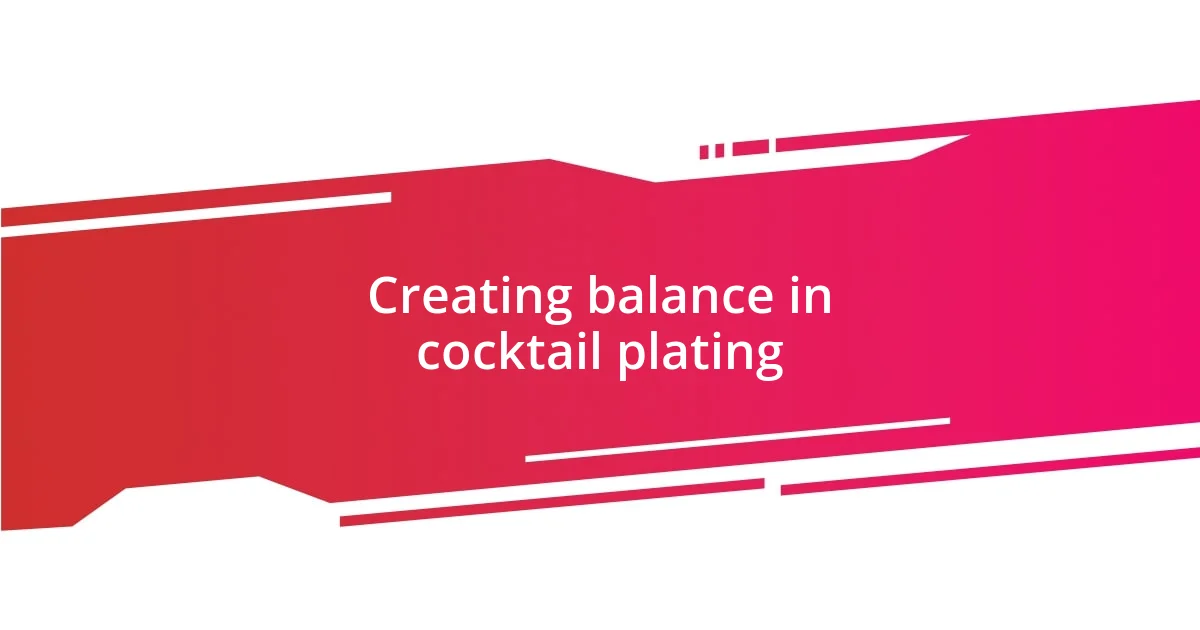
Creating balance in cocktail plating
Creating balance in cocktail plating involves not just the arrangement of elements, but also their interaction with one another. I remember preparing a cocktail that featured a vivid garnished sprig of mint atop a frothy drink. The mint not only added a refreshing aroma but provided a pop of color that pulled together the visual presentation. Isn’t it intriguing how one simple herb can tie a drink together, both in flavor and aesthetic?
Balancing flavors, colors, and textures is essential for making a cocktail visually appealing. One night, I crafted a vibrant drink using a bright pink hibiscus infusion, balancing it with a crunchy dehydrated lime wheel on the rim. This combination drew attention, but what truly struck me was how the herbaceous notes from the hibiscus harmonized with the crunch of the lime, creating a sensory experience that extended beyond sight. Have you thought about how including contrasting textures can make your cocktails even more inviting?
The placement of each element is vital for achieving harmony in a cocktail’s presentation. I recall a particularly elegant martini adorned with an elongated twist of lemon, strategically placed to wrap around the glass rim. This not only created a visual statement but also guided the drinker’s senses as they prepared to sip. It’s moments like these that remind me how thoughtful plating can elevate an ordinary drink into a work of art. What elements do you think you could play with to enhance the balance in your own cocktail creations?

Tips for serving cocktails effectively
When it comes to serving cocktails effectively, presentation plays a crucial role. I’ve learned that using the right glassware can elevate the overall experience. For example, serving a classic mojito in a tall, clear glass not only showcases the vibrant colors of the muddled mint and lime but also invites guests to sip in anticipation. Have you ever noticed how the shape and style of a glass can influence your perception of the drink inside?
Garnishes are another incredible opportunity to enhance your cocktails. One time, I zestfully incorporated edible flowers into a gin and tonic, creating a visual feast that had my friends excited to taste. The floral notes not only complemented the botanicals in the gin but also added an unexpected element to the drinking experience. Aren’t garnishes the perfect finishing touch to convey creativity and care in cocktail presentation?
Lastly, the way you present a cocktail can set the mood even before your guests take a sip. I remember serving a smoky mezcal drink with a dramatic flair—placing it on a wooden board with charcoal briquettes for a rustic effect. The visual was captivating, and my friends couldn’t wait to sample the drink. How do you think adding an element of surprise in your presentation might change the atmosphere at your gatherings?



